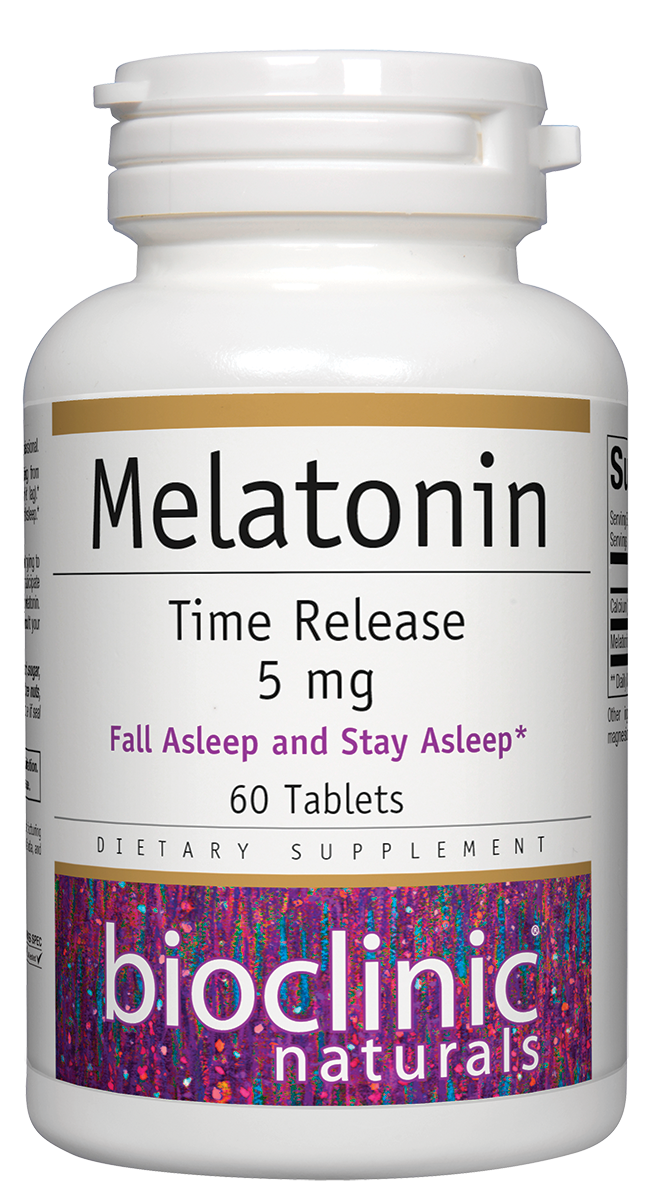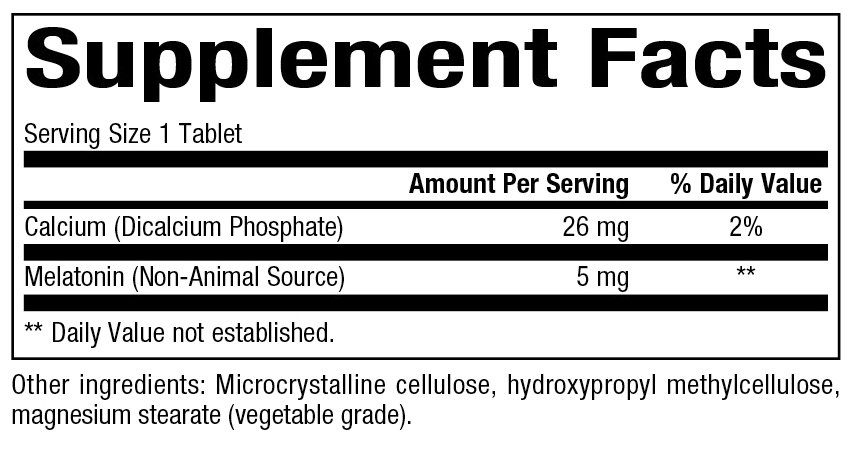
5 mg Time Release
5 mg
60 Tablets ( SKU: 9290U )
Benefits
- 5 mg timed-release melatonin per tablet
- Timed-release formulation sustains plasma levels for a longer period,1 helping to maintain the body’s sleep-wake cycle*
- Helps increase the total sleep time (aspect of sleep quality) in people suffering from occasional sleep restriction or altered sleep schedule (e.g., shift-work and jet lag)*
- Supports alertness during waking hours and helps reduce the time it takes to fall asleep*
- Suitable for vegetarians/vegans
- Non-habit forming
Feature Summary
Sleep is a vital part of health and many of us are not getting enough of it. Changes in sleeping patterns are largely reflective of our circadian rhythms, which are guided by the pineal hormone, melatonin. Melatonin plays a major role in the circadian regulation of the sleep-wake cycle, and is important for both initiation and quality of sleep.* Supplementation may help support a healthy sleep-wake cycle, in those both with and without occasional sleep challenges.*2 Timed-release melatonin helps support normal sleep initiation and healthy sleep maintenance.*3,4
Melatonin helps increase the total sleep time (aspect of sleep quality) in people suffering from occasional sleep restriction or altered sleep schedule (e.g., shift-work and jet lag).*5,6 While 10–30% of US adults report occasional sleep difficulties,7 that number rises to 50% of older adults.8 Older adults sleep less, overall, regardless of endogenous melatonin levels, and supplemental melatonin may help support a normal sleep-wake cycle.*9,10 Melatonin may also help maintain healthy sleep in children.*11,12,13,14 Timed-release melatonin may help support a healthy mood and help maintain normal cognitive performance with occasional sleep challenges.*3,4
Supplement Facts:

Dosage:
Suggested Usage: 1 tablet per day at bedtime or as directed by a health care professional.
Allergens:
Contains no artificial colors, preservatives, or sweeteners; no dairy, starch, sugar, wheat, gluten, yeast, soy, corn, egg, fish, shellfish, animal products, salt, tree nuts, or GMOs. Suitable for vegetarians/vegans.
Contraindications
Consumption with alcohol, other medications or natural health products with sedative properties is not recommended.
Drug Interactions
Melatonin may impair glucose utilization and increase insulin resistance in diabetic patients. However, the clinical significance of this effect on diabetics is unknown.15 Contraceptive drugs can increase endogenous melatonin levels. Theoretically, this may increase the effects and adverse effects of oral melatonin use.16 Fluvoxamine significantly inhibits the elimination of melatonin,17 which may have additive effects.18 This interaction may cause excessive unwanted drowsiness and other adverse effects. Melatonin production and release may be inhibited by beta-blockers and non-steroidal anti-inflammatory drugs.19,20
- Seiden, D.J., & Shah, S.M. (2019). The Primary Care Companion for CNS Cisorders, 21(4), 19m02450.
- Costello, R.B., Lentino, C.V., Boyd, C.C., et al. (2014). Nutrition Journal, 13(1), 106.
- Serfaty, M.A., Osborne, D., Buszewicz, M.J., et al. (2010 International Clinical Psychopharmacology, 25(3), 132-42.
- Wade, A.G., Farmer, M., Harari, G., et al. (2019). Clinical Interventions in Aging, 9, 947-61.
- Kunz, D., Mahlberg, R., Müller, C. (2004). The Journal of Clinical Endocrinology and Metabolism, 89(1), 128-34.
- Bjorvatn, B., & Pallesen, S. (2009). Sleep Medicine Reviews, 13(1), 47-60.
- Maness, D. L., & Khan, M. (2015). American Family Physician, 92(12), 1058-64.
- Crowley K. (2011). Neuropsychology Review, 21(1), 41-53.
- Wade, A.G., Ford, I., Crawford, G., et al. (2010). BMC Medicine, 8(1), 51.
- Wade, A.G., Ford, I., Crawford, G., et al. (2007). Current Medical Research & Opinion, 23(10), 2597-605.
- Wasdell, M.B., Jan, J.E., & Bomben, M.M. (2008). Journal of Pineal Research, 44(1), 57-64.
- Carr, R., Wasdell, M.B., Hamilton, D., et al. (2007) Journal of Pineal Research, 43(4), 351-9.
- Chang, Y.S., Lin, M.H., Lee, J.H., et al. (2016). JAMA Pediatr. 170(1), 35-42.
- De Leersnyder, H., Zisapel, N., & Laudon, M. (2011). Pediatric Neurology, 45(1), 23-6.
- Cagnacci, A., Arangino, S., Renzi, A., et al. (2001). Clinical Endocrinology, 54(3), 339-46.
- Wright Jr, K.P., Myers, B.L., Plenzler, S.C., et al. (2000). Brain Research, 873(2), 310-7.
- Hartter, S., Grozinger, M., Weigmann, H., et al. (2000). Clinical Pharmacology & Therapeutics, 67(1), 1-6.
- Grozinger, M., Hartter, S., Wang, X., et al. (2000). Archives of General Psychiatry, 57(8), 812-3.
- Stoschitzky, K., Sakotnik, A., Lercher, P., et al. (1999). European Journal of Clinical Pharmacology, 55, 111-5.
- Murphy, P.J., Myers, B.L., Badia, P. (1996). Physiology & Behavior, 59(1), 133-9.
